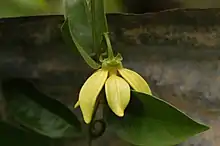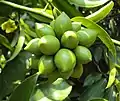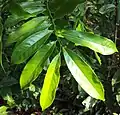Artabotrys hexapetalus
Manoranjitham, the climbing ylang-ylang, is a shrub found in India through to Burma, southern China and Taiwan,[1] having flowers that are renowned for their exotic fragrance.[2] It is also called ylang-ylang vine or tail grape in English, with a variety of names in other languages.[2][1] The yellow colored flowers of this plant are very fragrant.[3] The flowers are greenish in the beginning and turn yellow with age and the flowers are long lasting with fruity pleasant smell.[2] When young it is a shrub which turns into a climber once attains the height of about 2 meters.[1]
| Artabotrys hexapetalus | |
|---|---|
 | |
| Artabotrys hexapetalus flower | |
| Scientific classification | |
| Kingdom: | Plantae |
| Clade: | Tracheophytes |
| Clade: | Angiosperms |
| Clade: | Magnoliids |
| Order: | Magnoliales |
| Family: | Annonaceae |
| Genus: | Artabotrys |
| Species: | A. hexapetalus |
| Binomial name | |
| Artabotrys hexapetalus | |
| Synonyms | |
| |
Gallery
 Fruits
Fruits Leaves
Leaves Hook
Hook
See also
- Cananga odorata, tree which is the source of ylang-ylang oil.
- Artabotrys odoratissimus also called ylang-ylang vine.
- Desmos chinensis, dwarf ylang-ylang.
References
- "Artabotrys hexapetalus". Asianplant.net. Retrieved 2013-03-25.
- "Artabotrys hexapetalus - Hari Champa". Flowersofindia.net. Retrieved 2013-03-25.
- "Artabotrys hexapetalus - Hortipedia". En.hortipedia.com. 2009-04-21. Retrieved 2013-03-25.
External links
| Wikimedia Commons has media related to Artabotrys hexapetalus. |
| Wikispecies has information related to Artabotrys hexapetalus. |
This article is issued from Wikipedia. The text is licensed under Creative Commons - Attribution - Sharealike. Additional terms may apply for the media files.